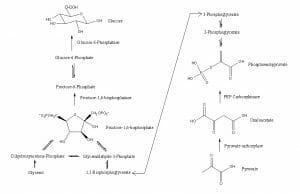Gluconeogenesis Definition
Gluconeogenesis is the formation of new glucose molecules in the body as opposed to glucose that is broken down from the long storage molecule glycogen. It takes place mostly in the liver, though it can also happen in smaller amounts in the kidney and small intestine. Gluconeogenesis is the opposite process of glycolysis, which is the breakdown of glucose molecules into their components.
Function of Gluconeogenesis
Our bodies produce glucose to maintain healthy blood sugar levels. Glucose levels in the blood must be maintained because it is used by cells to make the energy molecule adenosine triphosphate (ATP). Gluconeogenesis occurs during times when a person has not eaten in a while, such as during a period of famine or starvation. Without food intake, blood sugar levels become low. During this time, the body does not have an excess of carbohydrates from food that it can break down into glucose, so it uses other molecules for the process of gluconeogenesis such as amino acids, lactate, pyruvate, and glycerol instead. Once glucose is produced through gluconeogenesis in the liver, it is then released into the bloodstream, where it can travel to cells of other parts of the body so that it may be used for energy.
The process of gluconeogenesis is sometimes referred to endogenous glucose production (EGP) because it requires the input of energy. Since gluconeogenesis is the opposite of glycolysis, and glycolysis releases a lot of energy, it would be expected that gluconeogenesis would require the input of a lot of energy. However, gluconeogenesis occurs when the body is already low on energy, so it requires workarounds in order to use less energy. Therefore, some steps of gluconeogenesis cannot be performed in a way that is simply the reverse of glycolysis; instead, the cell has developed slightly different ways to perform the process, as can be seen in the gluconeogenesis pathway when it is compared to the glycolysis pathway. Although it may seem counterintuitive that the gluconeogenesis uses energy when the body needs more energy, the process ultimately pays off when glucose enters cells and is used to create ATP.
Glycogenolysis is another process that is used when glucose levels in the blood are low. During glycogenolysis, the storage molecule glycogen—which is made up of long chains of glucose—is broken down into glucose which then enters the blood. The main difference between glycogenolysis and gluconeogenesis is that glycogenolysis involves the formation of glucose molecules from a glucose source (glycogen), while gluconeogenesis forms glucose from non-glucose sources, molecules that are not made up of glucose. Also, glycogenolysis is an exergonic process; it releases energy. Gluconeogenesis is called endogenous glucose production (EGP) in order to differentiate it from glycogenolysis.
Gluconeogenesis and glycogenolysis have a similar function, but they are used somewhat differently. Glycogenolysis is more often used during shorter periods of fasting, such as when a person’s blood sugar drops in between meals or after a good night’s sleep, while gluconeogenesis is used during long periods of fasting. However, both processes are always occurring at some level in the body because glucose is important for producing energy. Organs such as testes, red blood cells, kidneys, and parts of the eye such as the retina use glucose as their sole energy source, and other parts of the body also have a high demand for glucose, such as the brain and muscles.
Gluconeogenesis Pathway
- Gluconeogenesis begins in either the mitochondria or cytoplasm of the liver or kidney. First, two pyruvate molecules are carboxylated to form oxaloacetate. One ATP (energy) molecule is needed for this.
- Oxaloacetate is reduced to malate by NADH so that it can be transported out of the mitochondria.
- Malate is oxidized back to oxaloacetate once it is out of the mitochondria.
- Oxaloacetate forms phosphoenolpyruvate using the enzyme PEPCK.
- Phosphoenolpyruvate is changed to fructose-1,6-biphosphate, and then to fructose-6-phosphate. ATP is also used during this process, which is essentially glycolysis in reverse.
- Fructose-6-phosphate becomes glucose-6-phosphate with the enzyme phosphoglucoisomerase.
- Glucose is formed from glucose-6-phosphate in the cell’s endoplasmic reticulum via the enzyme glucose-6-phosphatase. To form glucose, a phosphate group is removed, and glucose-6-phosphate and ATP becomes glucose and ADP.

This diagram shows the gluconeogenesis pathway.
Quiz
1. Which process is the opposite of gluconeogenesis?
A. Glycogenolysis
B. Glycogenesis
C. Glyceroneogenesis
D. Glycolysis
2. Gluconeogenesis is a(n) ______ process.
A. Endogenous
B. Exogenous
C. Neither endogenous nor exogenous
3. What is the main body organ where gluconeogenesis takes place?
A. Kidney
B. Brain
C. Liver
D. Mitochondria
References
- n.a. (n.d.) “Glycolysis and Gluconeogenesis.” Khan Academy. Retrieved 2017-05-03 from https://www.khanacademy.org/test-prep/mcat/biomolecules/carbohydrate-metabolism/a/glycolysis-and-gluconeogenesis
- n.a. (2013-11-04). “Difference Between Glycogenolysis and Gluconeogenesis.” Difference Between. Retrieved 2017-05-03 from http://www.differencebetween.com/difference-between-glycogenolysis-and-gluconeogenesis/.
- Diwan, Joyce J. (2007). “Gluconeogenesis; Regulation of Glycolysis & Gluconeogenesis.” Rensselaer Polytechnic Institute. Retrieved 2017-05-03 from https://www.rpi.edu/dept/bcbp/molbiochem/MBWeb/mb1/part2/gluconeo.htm.
- King, Michael W. (2017-03-23). “Gluconeogenesis: Endogenous Glucose Synthesis.” The Medical Biochemistry Page. Retrieved 2017-05-03 from https://themedicalbiochemistrypage.org/gluconeogenesis.php#intestine.
- Ophardt, Charles E. (2003). “Glycogenesis, Glycogenolysis and Gluconeogenesis.” Virtual ChemBook. Retrieved 2017-05-03 from http://chemistry.elmhurst.edu/vchembook/604glycogenesis.html.
Gluconeogenesis
No comments:
Post a Comment